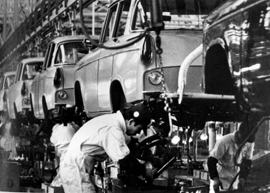
An assembly line at a Toyota automotive plant. Photo from 1961.
Photo from Mainichi Shimbun.
Beginning of the Japanese Automobile Industry
The history of the Japanese automobile industry dates back to the Taisho era (1912-1926). After World War I a number of corporations, guided by the government and the Imperial Army, started to produce military trucks. Later on, auto companies such as Toyota and Nissan started their business. That was essentially the beginning of the Japanese automobile industry. In 1933 or the early Showa era, a burgeoning corporation, Nihon Sangyo, established Nissan, and in the same year, a weaving machine company, Toyota Jido Shokki, which later became Toyota, founded its automobile department. However, the Japanese automobile industry was insignificant throughout World War II, and auto corporations produced almost only military and industrial trucks and buses. Indeed, in those days, it was very rare that an average Japanese household owned a car.
After WWII the Allied Occupation General Headquarters banned automobile production until 1950—Japanese companies were allowed to produce only a limited number of trucks. Then, Nissan and Toyota restarted their businesses. Soon Toyota nearly went bankrupt, mainly because of a severe dispute with its union workers. Throughout the Korean War, however, GHQ awarded contracts toToyota for both military vehicles and repairs. As a result, Toyota survived its crisis.
|

